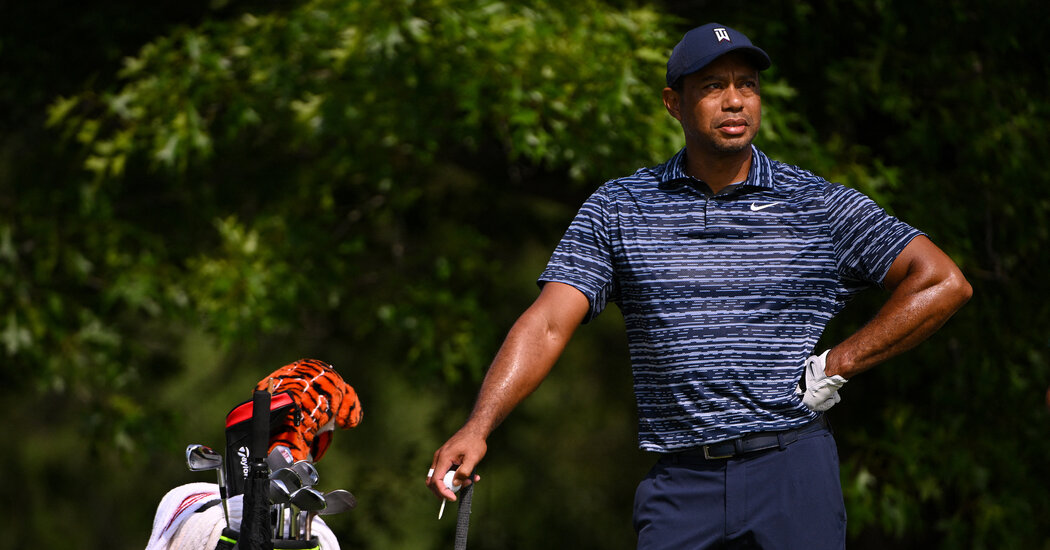
TULSA, Okla. — Tiger Woods has a good sense of humor, though it is rare for him to use it in a public setting. But at 46, he is evolving. What was once unthinkable for him — playfully mocking his poor play on the golf course — is one of his new, winsome tools.
On Thursday, six weeks after his stirring comeback at the Masters Tournament, Woods returned to competitive golf in the first round of the P.G.A. Championship. After a blazing start with two early birdies, Woods was limping a little on his right leg, which was surgically reconstructed after multiple serious fractures sustained in his horrific car crash early last year. A couple of holes later, Woods was limping a lot, even sometimes using a golf club like a cane to ascend or descend hills.
Not surprisingly, his score soon reflected his infirmity as he shot a four-over-par 74 with seven bogeys in his final 13 holes. After he had hobbled to a rostrum for a news conference, he was asked about his rebuilt leg.
“Yeah, not feeling as good as I would like it to be,” he said with a smile. Woods added that he could not put weight on his right leg in his backswing — known as loading — and he also struggled to push off his leg on the downswing, too.
“Loading hurts, pressing off it hurts, and walking hurts and twisting hurts,” he said.
Woods then deadpanned: “It’s just golf. If I don’t play that, if I don’t do that, then I’m all right.”
“We’ll start the recovery process and get after it tomorrow,” he added, predicting that his evening would include ice baths and myriad efforts to reduce inflammation in his right leg.
Tiger Woods’s Lasting Impact and Uncertain Future
The star golfer, one of the most influential athletes of the last quarter-century, is mounting a comeback after being badly injured in a car crash.
And so, Woods’s ongoing return to elite golf is following the bumpy, irregular progression that even he forecast before the Masters when he said he expected a series of good days and bad days.
“It’s a process,” Woods said.
Part of that process, as Woods acknowledged on Tuesday, was that his right leg and his ailing back, which has been operated on five times, no longer allowed him to practice for long periods of time, which had been routine for him since he was a kindergartner. While watching Woods play on Thursday, it was easy to wonder if some of his troubles on the golf course were related to a lack of preparation off it, especially for someone like Woods who was once renowned for exhausting work habits.
For example, one of Woods’s playing partners Thursday was Rory McIlroy, who is the first-round leader after a five-under-par 65. McIlroy successfully navigated the tricky sloping greens of the Southern Hills Country Club with deft chipping, bunker play and deadly accurate putting.
Woods’s short game was once probably his greatest strength, but on Thursday it let him down repeatedly. Moreover, Woods appeared uncomfortable, or unsure, over those shots, which was startling. Woods with a wedge or a putter in his hands had always been commanding and cocksure.
But on the sixth hole that Woods played Thursday, when he was still two under par for the round, he was in a greenside bunker with a fairly straightforward shot to the pin, which was 23 feet away. Shockingly, he blasted his shot 21 feet past the hole and made bogey.
Three holes later, playing the 18th hole because his group began its round on the 10th tee, Woods was in another greenside bunker and again thumped his ball 20 feet past the hole for a bogey. Even after Woods rallied for a birdie three holes later, another bunker shot on the next hole sailed over the green and led to yet another bogey.
Woods looked exasperated, and as often happens to any golfer, missteps in one facet of the game led to a lack of execution in another part of part of the game as Woods failed to convert several long- or medium-range putts. Keep in mind that some people think Woods was the greatest pressure putter of golf’s modern era.
Asked about his difficulties from the sand, Woods said: “Yeah, all the bunker shots sort of came out hot.”
But his bunker play was not the only way Thursday’s round seemed uncharacteristic for Woods. For more than 25 years, Woods was known as an aggressive golfer, and he all but invented the bombing-it-off-the-tee-with-a-driver style that has overtaken the sport.
But on Thursday, as McIlroy and the third golfer in the grouping, Jordan Spieth, launched drivers far down the fairway, Woods was hitting long irons and playing for position. Sometimes he was more than 60 yards behind McIlroy off the tee, although as Woods later said, not being able to push off his right leg caused him to slice shots to the right.
“I wouldn’t have been so far back if I would have hit the iron shot solid and put the ball in the fairway,” he said. “I was playing to my spots, and those guys obviously have a different game plan. The game is just different. It’s much more aggressive now, and I know that. But I was playing to my spots. If I would have hit the ball solidly on those two holes and put the ball in the fairway, I would have been fine.”
He continued: “But I didn’t do that. I put the ball in the rough.”
The smile that Woods brought to the beginning of his news conference was dissipating. The golf comeback that seemed unlikely only 15 months ago would continue Friday, Woods said. But before he walked away with a noticeable, lurching limp, Woods had a last comment.
“It was a frustrating day,” he said.




